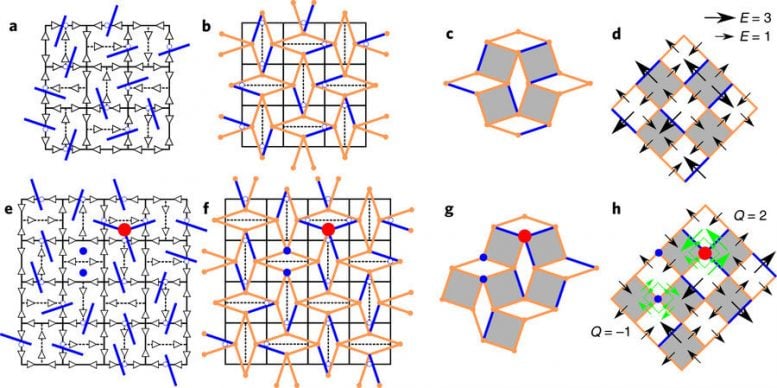
Fig. 3: The dimer model. a, Disordered moment ensemble for the ground state of Shakti artificial spin ice manifold: all z = 2 and z = 4 vertices are in the lowest energy configurations (type I4, type I2); however, only half of the z = 3 vertices are in the lowest energy (type I3) configuration, and the other half are excited unhappy vertices (type II3). b, Each unhappy vertex, indicated by an open circle, can be represented as a dimer (blue segment) connecting two rectangles, making the ground state equivalent to the decoration of a complete dimer-cover lattice (orange lines) with vertices (orange dots) in the centers of the Shakti lattice rectangles. c, The dimer cover without the underlying Shakti lattice is composed of squares and rhombuses and is topologically equivalent to a square lattice. d, The equivalent square lattice, also showing the emergent vector field, EE, perpendicular to the edges. The field EE has magnitude 1 (3) if the edge is unoccupied (occupied) by a dimer, and direction entering (exiting) a grey square along 135°, and exiting (entering) it along 45°. e, Sample experimental data showing moment configurations with excitations above the ground state of Shakti artificial spin ice. Red and blue dots denote the locations of the excitations. f, g, The corresponding emergent dimer-cover representations. Excitations over the ground state correspond to any cover lattice vertices with dimer occupation other than one. h, A topological charge, Q, can be assigned to each excitation by taking the circulation of the emergent vector field around any topologically equivalent anticlockwise loop γ (dashed green path) encircling them. Credit: Nature Physics (2018) doi:10.1038/s41567-018-0077-0
An intricate lattice of microscopic magnets has led researchers to observe behavior that is reminiscent of the complexities of quantum mechanical systems, but in the context of a purely classical system.
In a new study published online on April 2 in the journal Nature Physics, scientists describe new studies of a form of artificial spin ice — a nanometer-scale configuration of magnets so small that their north and south poles spontaneously flip back and forth at room temperature. They find that a particular configuration of artificial spin ice, called Shakti spin ice, also displays the sort of topological order more commonly studied in association with quantum mechanical systems.
Peter Schiffer, Yale’s vice provost for research and professor of applied physics, helped to lead the research, which included scientists from the University of Illinois at Urbana-Champaign, Los Alamos National Laboratory, the University of Minnesota, and Lawrence Berkeley National Laboratory.
Schiffer’s team measured these systems and noticed something unusual in that this array of nanomagnets did not settle into a particular configuration of the magnet poles, unlike other forms of artificial spin ice. Instead, the Shakti spin ice maintained a higher energy level, even when scientists lowered the system’s temperature.
“The system gets stuck in a way that it cannot rearrange itself, even though a large-scale rearrangement would allow it to fall to a lower energy state,” Schiffer said. This outcome is a direct result of how the lattice is connected geometrically, i.e., its topology.
Further work by the researchers showed that the material achieved a low-energy state that could be mapped exactly into a well-known theoretical model — the dimer cover model — that had recognizable topological properties.
“The demonstration that these topological effects can be designed into an artificial spin ice system opens the door to a wide range of possible new studies,” Schiffer said. The possibilities appear particularly interesting, he noted, because complex topological effects appear in many places in nature, and artificial spin ice offers a system in which they can be designed, controlled, and studied in detail.
Reference: “Classical topological order in the kinetics of artificial spin ice” by Yuyang Lao, Francesco Caravelli, Mohammed Sheikh, Joseph Sklenar, Daniel Gardeazabal, Justin D. Watts, Alan M. Albrecht, Andreas Scholl, Karin Dahmen, Cristiano Nisoli and Peter Schiffer, 2 April 2018, Nature Physics.
DOI: 10.1038/s41567-018-0077-0
The study’s authors, in addition to Schiffer, are Yuyang Lao, Mohammed Sheikh, Joseph Sklenar, Daniel Gardeazabal, and Karin Dahmen of the University of Illinois at Urbana-Champaign; Cristiano Nisoli and Francesco Caravelli of Los Alamos; Justin Watts and Alan Albrecht of the University of Minnesota; and Andreas Scholl of Lawrence Berkeley National Laboratory. The work by Schiffer’s group was supported by the U.S. Department of Energy, Office of Basic Energy Sciences, Materials Sciences and Engineering Division.

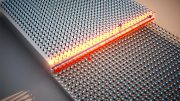
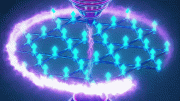
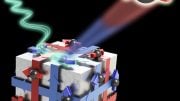
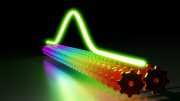
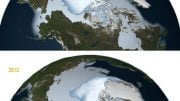

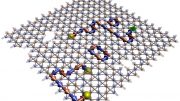
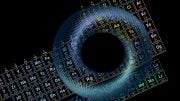
Be the first to comment on "Scientists Describe a New Configuration of Artificial Spin Ice"